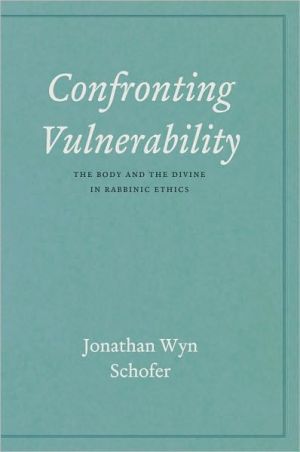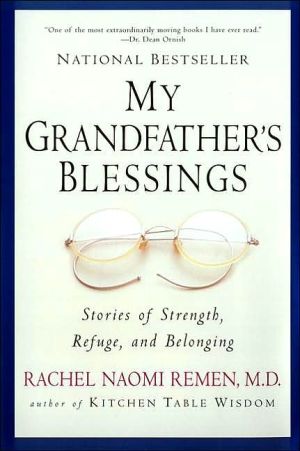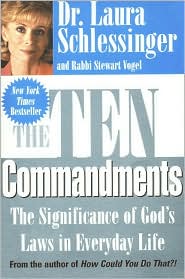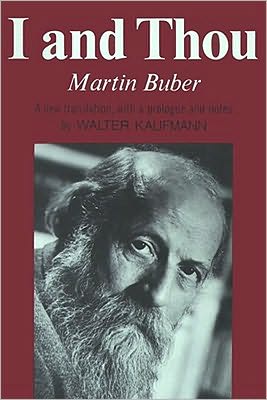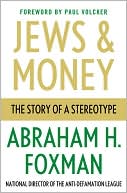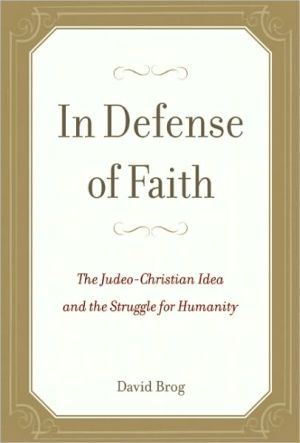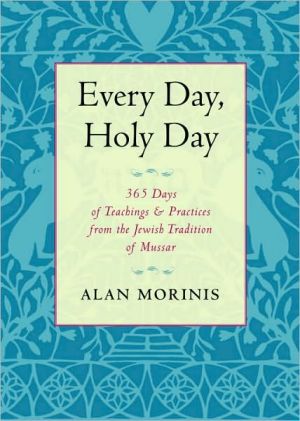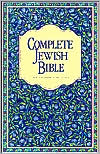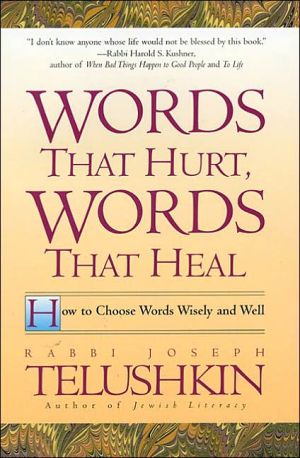Confronting Vulnerability: The Body and the Divine in Rabbinic Ethics
While imparting their ethical lessons, rabbinic texts often employ vivid images of death, aging, hunger, defecation, persecution, and drought. In Confronting Vulnerability, Jonathan Wyn Schofer carefully examines these texts to find out why their creators thought that human vulnerability was such a crucial tool for instructing students in the development of exemplary behavior.\ These rabbinic texts uphold virtues such as wisdom and compassion, propound ideal ways of responding to others in...
Search in google:
While imparting their ethical lessons, rabbinic texts often employ vivid images of death, aging, hunger, defecation, persecution, and drought. In Confronting Vulnerability, Jonathan Wyn Schofer carefully examines these texts to find out why their creators thought that human vulnerability was such a crucial tool for instructing students in the development of exemplary behavior.These rabbinic texts uphold virtues such as wisdom and compassion, propound ideal ways of responding to others in need, and describe the details of etiquette. Schofer demonstrates that these pedagogical goals were achieved through reminders that one’s time on earth is limited and that God is the ultimate master of the world. Consciousness of death and of divine accounting guide students to live better lives in the present. Schofer’s analysis teaches us much about rabbinic pedagogy in late antiquity and also provides inspiration for students of contemporary ethics. Despite their cultural distance, these rabbinic texts challenge us to develop theories and practices that properly address our frailties rather than denying them.
Confronting Vulnerability\ The Body and the Divine in Rabbinic Ethics \ \ By JONATHAN WYN SCHOFER \ The University of Chicago Press\ Copyright © 2010 The University of Chicago\ All right reserved.\ ISBN: 978-0-226-74009-6 \ \ \ Chapter One\ Aging and Death \ The most distinctive literary form in ethical anthologies is the short maxim or saying. This chapter centers on two maxims and their incorporation into midrashic and Talmudic discussions. The first is the saying of Akavya ben Mahalalel quoted in the introduction: "Look upon three things and you will not come into the hands of transgression ..." (m. Avot 3:1). The second is attributed to the first-century Rabbi Eliezer ben Hyrcanus: "Repent one day before your death" (m. Avot 2:10). Both maxims direct attention to the future and particularly each person's future in death, but in different ways. Akavya ben Mahalalel emphasizes the inevitability of death, subsequent decay, and God's final judgment. From this perspective, many preoccupations appear insignificant. Rabbi Eliezer focuses on the ever present possibility of death, the fact that death may come to any person at any moment. The mental discipline generates urgency and counters procrastination.\ Spiritual Exercises, Death, and Divine Justice\ Scholars have increasingly drawn upon the category "spiritual exercise" to describe practices of self-cultivation as well as links in philosophical and religious writings between thought and action, the love of wisdom and the arts of living. Such exercises set out ways to transform one's natural or given state to attain virtues and skills. The phrase is problematic. "Spiritual" carries unhelpful cultural baggage, so I drop this adjective. "Exercise" is vague, so I consider a specific kind of exercise in which thinkers attend to death in order to transform mental states, emotions, and behavior.\ Several philosophical sources are roughly contemporary with the rabbinic maxims and have similar temporal orientations. For example, Marcus Aurelius lived in the second century (121–180 C.E.), after Akavya ben Mahalalel and Rabbi Eliezer, and before the compilation of Mishnah Avot. In his Meditations, Marcus Aurelius emphasizes the ultimate end of all things, including our selves, in decay. When death comes, many worries of everyday life become irrelevant. All things, and even the memories of all things, quickly vanish. Everything that entices or terrifies is ephemeral. Given these conditions, the guide for life is philosophy (2:12; 2:17). Elsewhere, Marcus Aurelius repeatedly upholds living each day as if it were one's last, for death may interrupt life at any moment. The prescription can appear as a general maxim opening a larger discussion:\ In the conviction that it is possible you may depart from life at once, act and speak and think in every case accordingly (2:11).\ A person with ideal character can live each day as if it were the last, "neither feverish nor apathetic, and not to act a part" (7:69).\ Richard Sorabji has made two observations regarding these philosophical exercises that carry over to the rabbinic maxims. First, they reveal an asymmetrical attitude to the past and future. Despite Epicurean arguments to the contrary, the future is a greater concern than the past. Fear of death is more of a problem than fear of the time before birth. Fear of losing mental capacities in old age is more of a problem than fear of having had infantile capabilities. In the maxim of Akavya ben Mahalalel, this asymmetrical attitude is quite concrete: one of the three foci of attention is in the past (you come from a putrid drop) and two are in the future (you will become dust, worm, and maggot; and God will judge you). Second, these exercises attend to the future in order to change orientation in the present. In the rabbinic cases, the goal is that a person repents or does not "come into the hands of transgression."\ We can see several differences along with these commonalities. Many late ancient Stoic and other philosophical exercises aim to transcend subjectivity through focus on the natural world, freeing oneself from fear and other emotions. For Akavya ben Mahalalel and Rabbi Eliezer, the goal is to intensify one's affective relation with a deity that rewards and punishes, inspiring humility, anxiety, and vigilance. More generally, rabbinic sources present a tension between two orientations toward death. On one hand, death is a difficult bodily process. Rabbis mourn others who have died, do not want to die young, and do not relish the body's decline in the days leading up to death and beyond. On the other hand, many passages situate death in relation to God's judgment. Death brings a shift in human relations with God, for divine accounting concludes and a person can no longer perform the commandments, earn merit, or repent for transgression. In addition, death and decay may not be the ultimate end of the body, for God's judgment can bring resurrection and life in a world to come. Ethical instruction often invokes the possibility of this future life as well as the threat of perishing—both are implied in the maxims of Akavya ben Mahalalel and Rabbi Eliezer.\ Sometimes rabbinic texts refer to divine justice with specific phrases such as God's "measure of justice" (middat ha-din). More often, we find legal and monetary metaphors. Akavya ben Mahalalel presents God as a king and judge, with humans implied as subjects and defendants. In other passages, God may be a storekeeper or employer, with humans as creditors or servants. Rabbinic usages of these images bring great subtleties and require adaptation of the term "theology." If theology means thought that is systematic, abstract, and modeled upon philosophical modes of argumentation, then the term is inappropriate. Rabbinic theologies of divine justice, moreover, do not presume a philosophical theory of justice. For comparative purposes, theology needs to include the full range of images and genres used to discuss a deity or deities.\ Midrash and Vulnerability: Ecclesiastes 12:1–7\ Rabbinic editors take up the maxim of Akavya ben Mahalalel and that of Rabbi Eliezer, and link each with a long exegesis of a beautiful poem in Ecclesiastes 12:1–7. This midrash is arguably the most extensive treatment of old age in rabbinic literature. The earliest version of the midrash appears in the Palestinian amoraic Leviticus Rabbah 18:1, which I analyze in full. This passage cites Akavya ben Mahalalel's saying at the outset, and much of the discussion can be seen as an elaboration of the sage's call to "look" at "where you go" in the future. The midrash traveled through many editorial streams. In the Babylonian Talmud, a very elaborate sugya' about aging and death exposits the poem and concludes with an expansion of Rabbi Eliezer's maxim upholding repentance (b. Shab. 151b–153a). I summarize key points of contrast between the Palestinian and Babylonian versions, and then focus on Rabbi Eliezer's saying and its commentary.\ These microforms inspire questions relating to coherence and integration. Put bluntly: how readable are these rabbinic texts? I argue that we see thematic continuity and general consistency of outlook in Leviticus Rabbah 18:1. This unit reveals a powerful set of pedagogical styles, subtleties in rabbinic theologies of divine justice, and a movement from aging to death, burial, and beyond. We also find, within the overarching genre of midrash, many different sub-genres including maxims, lists, poetry, narratives, parables, and apodictic law. The text presents strong shifts in content and mood, places that seem messy or needing emendation, and at times conflicting positions. These upheavals present obstacles for reading. These upheavals also undermine fixities regarding aging and death, for bodily processes do not appear as singular events to be grasped in simple terms.\ In order to see the interpretative work done by the midrash, we should first consider the biblical verses in their plain senses. Ecclesiastes 12:1–8 presents numerous metaphors that have troubled scholarly interpreters. Any rendering of the images into English requires some overall theory of what the poem portrays, and a neutral translation is difficult. Despite this, I attempt to stay close to the Hebrew with its ambiguities:\ (12:1) Remember your creator in the days of your youth, before ('ad 'asher lo') the days of unpleasantness come, and years arrive of which you say, I have in them no joy,\ (12:2) before ('ad 'asher lo') the sun darkens, and the light, and the moon and stars, and the clouds return after the rain,\ (12:3) in the day when the keepers of the house tremble, and the powerful men writhe,\ and the grinders are idle for they have dwindled, and those looking through the lattices darken,\ (12:4) and the double-doors in the market are closed, when the sound of the mill lowers,\ and he rises to the voice of the bird, and all the woman singers are bowed low,\ (12:5) and also they fear from on high, and terrors are along the way, and the almond tree blossoms, and the locust is laden, and the caper-berry fails,\ for the man goes to his eternal home, and the mourners surround the market,\ (12:6) before ('ad 'asher lo') the silver cord snaps, and the golden bowl is smashed, and the jug breaks upon the spring, and the wheel is smashed in the pit,\ (12:7) and the dust returns to the earth as it was, and the life-breath returns to God, who gave it.\ (12:8) Vanity of vanities, says Kohelet, everything is vanity!\ The poem has three sections. The poem tells the listener or reader to remember one's creator "before" ('ad 'asher lo') three things: before unpleasant days arrive (12:1), before one day in which many enigmatic things happen (12:2-5), and before various objects break and dust returns to the earth (12:6-7).\ What do these images represent? Some scholars say that this poem depicts the body's aging. Others suggest a funeral and communal mourning. Another interpretation takes the imagery to be eschatological. The rabbinic midrash contains all three elements, and perhaps the biblical poem carries no single meaning all the way through. Certain words and clauses generate great difficulties. In looking ahead to the rabbinic interpretation, three features are salient. First, Ecclesiastes does not necessarily describe human aging, and the metaphors do not have to be interpreted as body parts. Second, the poem does not make distinctions between sages and non-sages, the educated and those who are not, the righteous and the wicked. Rather, changes happen regardless of status or piety. Third, the poem ends (at least arguably) with verse 12:8 describing the utter absurdity or futility of everything, which is a common motif in Ecclesiastes. The rabbinic exegesis, by contrast, interprets many images as the decline of the body with age, has a recurring interest in the difference between those who are educated or pious and those who are not, and omits the last verse.\ Looking Upon Aging and Death (i): The Body, the Cosmos, and the Graceful Aging of a Sage (Lev. Rab. 18:1 to Lev. 15:2 and Eccles. 12:1)\ Leviticus Rabbah 18:1 calls for a strong orientation toward God's judgment, in this world and after an embodied resurrection. The text also faces bodily decline for all people, ending in death, regardless of ethical status. Both divine reckoning and material limitation motivate an aspiring sage to act correctly. This midrash is structured according to a specific form known as the petihta', or "opening." The core verse is a law from the Book of Leviticus addressing male genital discharge: "When any man has a discharge from his body, he is in the status of impurity" (Lev. 15:2). Rather than comment upon this verse directly, rabbis juxtapose this line with Ecclesiastes 12:1: "Remember your creator in the days of your youth...." The exegetical play centers on how the passages will be brought together.\ The unit opens by quoting the maxim of Akavya ben Mahalalel, which triangulates the two verses:\ When any man has a discharge from his body, he is in the status of impurity (Lev. 15:2). Remember your creator ([TEXT NOT REPRODUCIBLE IN ASCII.]) in the days of your youth (Eccles. 12:1).\ We learn, Akavya ben Mahalalel says: Look upon three things and you will not come into the hands of transgression. Know from where you come: from a putrid secretion. To where you go: to worm and maggot. Before whom in the future you will give account and reckoning: before the King of the kings of kings, the Holy One, blessed be He.\ Rabbi Abba bar Kahana in the name of Rabbi Pappi, and Rabbi Yehoshua of Siknin in the name of Rabbi Levi: Akavya derived all three of them from one word. Remember your origin ([TEXT NOT REPRODUCIBLE IN ASCII.]), your pit ([TEXT NOT REPRODUCIBLE IN ASCII.]), and your creator ([TEXT NOT REPRODUCIBLE IN ASCII.]). Remember your origin: this is a putrid secretion. Your pit: this is worm and maggot. Your creator: this is the King of the kings of kings, the Holy one, blessed be He, who in the future will give reckoning.\ The commentators link Akavya ben Mahalalel's maxim with Leviticus 15:2 through the common attention to that which flows from a penis. They reinterpret the "discharge" of Leviticus as the "putrid secretion" that is the origin of human life. The exegesis is more creative for Ecclesiastes 12:1. The verse begins by saying, "Remember [TEXT NOT REPRODUCIBLE IN ASCII.]." While a standard English translation is "Remember your creator," the spelling is unusual, and three letters bring opportunities for midrashic interpretation (the waw, 'alef, and yod: [TEXT NOT REPRODUCIBLE IN ASCII.]). A threefold exegesis calls for remembrance of one's [TEXT NOT REPRODUCIBLE IN ASCII.] or creator, one's [TEXT NOT REPRODUCIBLE IN ASCII.] or spring/origin, and one's [TEXT NOT REPRODUCIBLE IN ASCII.] or pit/grave. The elements of Akavya ben Mahalalel's teaching—God, birth, and death—are embedded in the letters of this one word.\ The midrash cites Akavya ben Mahalalel's maxim as an authoritative teaching supported by scripture. The historical relations between the sage and rabbinic culture, however, are more conflicted. Rabbinic literature remembers him as a controversial leader. Both the sage and the saying were initially problematic for rabbis. The Mishnah records a set of Akavya ben Mahalalel's legal decisions that were not accepted by his peers, who banned him. The discussion also addresses the state of his grave and a deathbed teaching to his son (m. Eduy. 5:6–7). We do not really know, though, exactly what the community was like in the first century, what a ban would have entailed, or even how to classify this sage: was Akavya ben Mahalalel a Pharisee, a proto-rabbi, or a rabbi in the period before scholars consider the rabbinic movement to have begun? I refer to him simply as a sage. Akavya ben Mahalalel's ethical maxim also generated controversy. Extensive commentaries in Rabbi Nathan A and B, and in Derekh Eretz Rabbah, indicate that the imagery disturbed later sages. In Mishnah Avot, however, the maxim takes a prominent place in the canon of rabbinic ethical instruction, and the appearance in Leviticus Rabbah marks a further stage in this embrace.\ What exactly does Akavya ben Mahalalel prescribe? The most important word setting out this exercise (histakkel, "look") is ambiguous and may convey intellectual understanding, meditative or contemplative focus, or some combination. I render the word in a very literal way as "look upon," drawing upon a sense of observation. Many options have been tried, each with a distinct nuance: attend to, observe, reflect, consider, mark well, meditate upon, look into, and contemplate. Late ancient readers also found the word unclear. Some versions of the maxim employ terms other than histakkel, calling for the student to "give" something to his "heart" or to "give" his heart to something. Another ambiguity is the frequency of this "looking." Is the prescription for all times, for various points throughout a day, or for specific moments? As a point of contrast, the medieval Muslim thinker al-Ghazali preserves a teaching that one should think about death twenty times a day. Akavya ben Mahalalel gives his followers no such specificity. As with many of the sayings in Mishnah Avot, the terse expression leaves many issues open for reflection through the centuries.\ At what point in life should you remember your creator, origin, and death? Following the elaborate opening exegesis, we find a deceptively simple line:\ In the days of your youth (Eccles. 12:1). In the days of your youthful vigor, while your strength is upon you.\ The instruction addresses a young person looking ahead to aging and death. This point is very important for interpreting the unit. Throughout the extensive discussion of aging and weakness that follows, we find a recurring concern with those in their physical prime and their orientation toward the divine. The young should "remember" before two times: "days of unpleasantness" and "years ... of which you say, I have in them no joy." The commentators understand these images to set out an opposition between old age and the messianic period:\ Before the days of unpleasantness come (Eccles. 12:1). These are the days of old age.\ And years arrive of which you say, I have in them no joy. These are the days of the messiah, which have neither merit nor debt.\ Old age is "unpleasant" because it brings suffering as well as ever-present trepidation regarding one's standing in relation to God. The promise of a messianic time offers hope that one can live without worry of judgment: "no joy" indicates not sorrow but rather being beyond joy and sorrow, and more specifically beyond the divine accounting that generates rewards and punishments. The call to remember, then, addresses those with youthful strength, anticipating both old age and the messiah.\ (Continues...)\ \ \ \ \ Excerpted from Confronting Vulnerability by JONATHAN WYN SCHOFER Copyright © 2010 by The University of Chicago. Excerpted by permission of The University of Chicago Press. All rights reserved. No part of this excerpt may be reproduced or reprinted without permission in writing from the publisher.\ Excerpts are provided by Dial-A-Book Inc. solely for the personal use of visitors to this web site. \ \
Acknowledgments IntroductionONE / Aging and Death TWO / Elimination THREE / Early Death FOUR / Drought FIVE / Life CyclesConclusion References Index
\ Martha C. Nussbaum“Engaging, clear, and fun to read, Confronting Vulnerability is an exciting book with that goes well beyond its specialist contribution. Because it engages with issues of fundamental human importance—how we confront our bodily nature, its weaknesses and its aging—it has something to offer to anyone who is interested in those questions. Furthermore, Schofer is an articulate and careful scholar with interesting observations about how to do comparative ethics.”\ \ \ \ \ Elizabeth Alexander“It is a rare scholarly book that is moving, but Confronting Vulnerability is. Jonathan Schofer elegantly synthesizes two different kinds of writing that might seem to be incompatible. On one hand, he provides rigorous, historically grounded, philologically sound, and imaginative textual analysis. At the same time, he coaxes the reader towards subjective personal reflection. This remarkable book makes an important contribution to the study of rabbinic culture by examining how rabbinic texts shaped an ethic for the historical adherents of the rabbinic movement. But more importantly, this is a book that is humanly compelling, asking us to contemplate the implications of having life framed by bodily fragility on one hand and divine judgment on the other. Confronting Vulnerability articulates poignantly, but without sentimentality, a unique perspective on the human condition.”\ \ \ Choice“This volume is an outstanding exploration—not only for its insight but also for its ability to make rabbinic ethics and insights accessible to those who lack facility in reading rabbinic sources in Hebrew. It is a major contribution to the religious ethics literature.”\ \ \ \ \ Phillip Sherman“Schofer has written a compelling work that focuses attention on issues that are often difficult to reflect upon. The texts examined are well-chosen, and he is clearly in command of both the primary rabbinic literature and the larger comparative ethical materials….book that not only adds to our knowledge of character formation in rabbinic texts but also provides scholars with another model for how to use a specialized academic discourse to engage questions of perennial importance.” \ \ \
